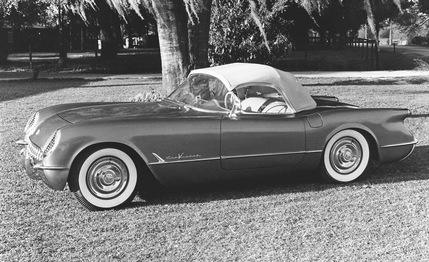
 Road Test
Road Test
As any astronomer will tell you, amazing things can happen when the stars line up just right. And in the early 1950s at General Motors, big stars were lining up behind a brand-new model destined to change the sports-car world forever.
Chevrolet had outsold Ford in 1949 and 1950, and division general manager Tom Keating was pressing for an exciting, youth-oriented new car to keep Chevy out in front. Then, in 1952, the innovative Ed Cole became chief engineer of Chevrolet, soon adding famed chassis specialist Maurice Olley to his team—the two were hungry to work on a new project together. Around the same time—ah, watch those stars align—GM design chief Harley Earl unveiled an idea he'd been harboring for more than a year. Inspired by the European sports cars he'd watched in 1951 at the Watkins Glen racetrack, Earl had made up his mind that GM should build a world-class sports car of its own—a trim, responsive machine crafted in the spirit of contemporary Jaguars, Porsches, and Triumphs. Given Keating's desire for a new model, and the available expertise of Cole and Olley, Chevrolet seemed the ideal division for the new car. Soon "Project Opel" (the team chose the name to confuse rival automakers) was off and running.
After months of feverish work, the prototype was ready in time for the January 1953 Motorama, held at New York's famed Waldorf Astoria hotel. When show visitors caught their first glimpses of the car, on January 17, they went wild. There, under the lights, sat a sports car the likes of which had never been seen before. It was lean. Low to the ground. Curvy. A toothy-grilled roadster with rocket-ship taillights and just enough room in the open cockpit for two adults and their ear-to-ear grins. It didn't have exterior door handles; it didn't even have roll-up side windows. It could have been another low-slung European bullet. But it wasn't. This sexy, svelte dream machine was from Chevrolet. The nose lettering said "Corvette."
There were more surprises. Not only was this stunning roadster American, it wasn't made of steel. Instead, the elegant, flowing bodywork was sculpted in fiberglass. The outbreak of the Korean War—and the resulting need to manufacture arms and matériel—had sharply curtailed the availability of steel. Not only was fiberglass readily obtainable, but it offered the additional advantages of light weight (a huge aid to performance) and dramatically lower cost. To a gadget-hungry 1950s public, fiberglass was also new and "cool." When it went into production later in 1953, the Corvette became the country's first-ever mass-produced fiberglass automobile.
Creating a car as radical as the Corvette was a huge gamble, of course, so at first Chevrolet was understandably reluctant to throw open its pocketbook for costly performance hardware and complicated extras. Thus, the original Corvette used mostly proven, off-the-shelf components under its stunning skin. The so-called "Blue Flame" in-line six-cylinder engine, for instance, was an overhead-valve, 235 cubic-inch passenger-car powerplant tweaked with three single-barrel carburetors and dual exhausts to develop a respectable 150 horsepower. It was mated to Chevy's popular two-speed Powerglide automatic transmission. Equally unassuming was Olley's chassis: the Corvette's body covered a simple, lightweight X-frame outfitted with production-sedan suspension pieces. The options list was minimal, too: just an AM radio and a heater.
Mild on the inside, perhaps, but the original Corvette was wild enough on the outside to qualify as a genuine sensation. More important, unlike most dream cars turning heads from the auto-show stands, the Corvette was a real car—a dream machine destined to electrify the American road. Starting slowly, building the cars largely by hand, Chevrolet crafted 300 Corvettes in 1953—all of them Polo White with red interiors. Base price for Chevy's new two-seater when it finally went on sale in September 1953: $3498.
Chevrolet had thrown down the gauntlet with its Motorama prototype, making a dramatic and bold entry into a sports-car arena previously dominated by the European brands. In the ensuing months, several hundred production Corvettes had rolled out from the factory doors. America had its first glimpse of the sports-car future—and it liked what it saw. Now it was up to Chevrolet to make its new star into a legend.